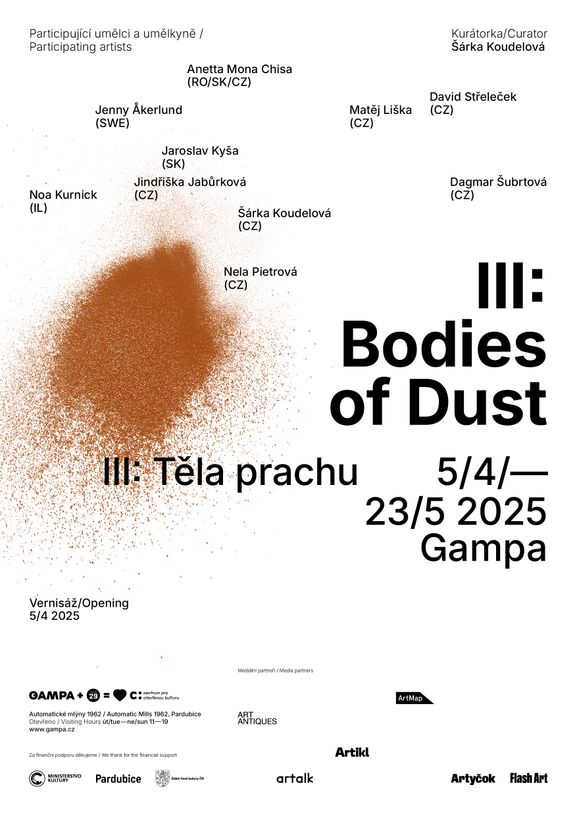+ Current program
III: Bodies of Dust › 5/4–23/5/2025


Participating artists: Jenny Ȧkerlund (SWE), Anetta Mona Chisa (RO/SK/CZ), Jindřiška Jabůrková (CZ), Noa Kurnick (IL), Jaroslav Kyša (SK), Šárka Koudelová (CZ), Matěj Liška (CZ), Nela Pietrová (CZ), David Střeleček (CZ), Dagmar Šubrtová (CZ)
Curator: Šárka Koudelová
Collaborators: GAMPA Pardubice, Vojtěch Novák, Ondřej Uherek, Nikola Březinová, Lucie Oplíštilová, Radka Francová, Jakub Štrba, Lukáš Kopecký
Technical collaboration on the exhibition architecture: Václav Hník
Educational programmes: Nikola Březinová
Graphic design: Tereza Drábková
The title of the exhibition and its principal line of thinking consciously reference Astrida Neimanis’s essay Bodies of Water, 2017. This exploration of water, an element that connects our bodies to planetary circulation, was a necessary articulation of the realisation that we are an integral part of the surrounding ecosystems, and we must, therefore, and for entirely selfish reasons, emmpathise with and care for them. III: Bodies of Dust extend this line of thought, thematising the parallels between the human body and experience and geological materials and processes. The exhibition is the third chapter in a loosely organised series of group exhibitions in which Šárka Koudelová combines her roles as artist and curator, seeking new forms of collaboration in the global environment that is the art scene. Like the preceding two chapters, (I: Too Close To Far, Prám, Praha, 2020 a II: Něžná / II: The Meek One, 2021, Karlin Studios, Praha, 2021) III: Bodies of Dust aims to serve as a multilayered and inclusive tool of communication that allows all participants to explore the topic from various perspectives. The ultimate goal is to foster a shared experience and physically and mentally connection all the works into one environment – or body.
The metaphor of the human body as dust, clay, or sand, with all its biblical connotations, is as ancient as our cultural consciousness. Nevertheless, it appears that this physical sense of belonging together with all matter on Earth must be updated. We feel the need to redefine it, utilising shared experiences to transform societal perceptions of the human body and the influences inscribed in everything it receives and absorbs – elements that crystallise, metamorphose, and become synthetic parts of the body. The spectrum of colour found in ceramic clay parallels the range of colours of human skin and internal organs. While the clay is wet, it has a malleable, almost fluid form. If it is mishandled or subjected to rapid temperature; it cracks, without moisture, it becomes brittle and disintegrates into dust. Just like our vulnerable bodies, it is directly dependent on the proportion of chemical elements and water content. Just like our disintegrating and regenerating bodies, it is part of all earthly and cosmic matter. Thanks to airstreams, we sometimes inhale air from the Sahara as well as stardust. Stardust, after all, can be understood as a pervasive, magical element that, according to the hypothesis known as panspermia, may have brought life to our planet in the form of microorganisms wandering through the galaxy in the form of solid microparticles.
The realisation that both living and non-living matter on Earth and across the cosmos is shared is an appeal to empathise with extra-systemic identities and non-human bodies. Consequently, we perceive the gallery space, built from clay bricks, as an equal organism – a body we share with visitors, and which is, at the same time, ours. Just as the bodies of a mother and child are eternally linked by cells that migrated in both directions, our works form part of the gallery’s body, elevated to the status of organs, or, at times, acting as burdensome kidney or bladder stones.
It is easy to identify with the clay body of the gallery – much like us, it has a spine. That is the axis of the entire bodily space, enabling it to stand erect as well as curl up and rest. Muscles rest upon it and it determines the rhythm of the spacing of the other body parts, providing them with support and protection. Dust mingles within the safe space inside the ribcage.
We thanks for the finacial support: Ministerstvo kultury ČR, Státní fond kultury, Statutární město Pardubice
Midia collaboration: Artalk.cz, Artikl, Artmap, Artyčok.tv, FlashArt, Art+Antiques
Accompanying program
+ Accompanying program

Dernissage of the exhibition III: Bodies of Dust
› Fri 23/5/2025 17:00
We cordially invite you to the dernissage of the exhibition III: Bodies of Dust.